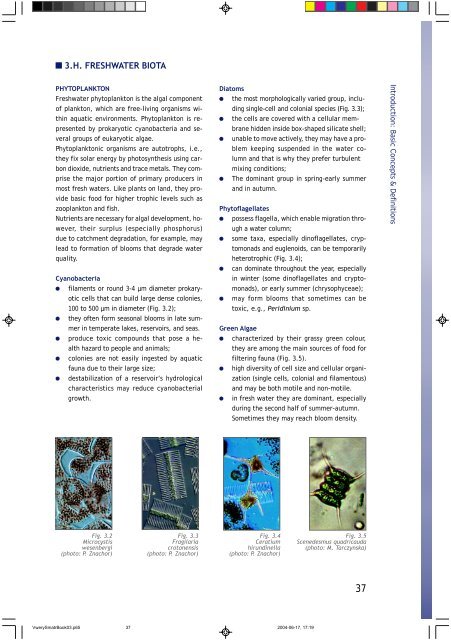Manual - International Environmental Technology Centre
Manual - International Environmental Technology Centre
Manual - International Environmental Technology Centre
Create successful ePaper yourself
Turn your PDF publications into a flip-book with our unique Google optimized e-Paper software.
3.H. FRESHWATER BIOTA<br />
PHYTOPLANKTON<br />
Freshwater phytoplankton is the algal component<br />
of plankton, which are free-living organisms within<br />
aquatic environments. Phytoplankton is represented<br />
by prokaryotic cyanobacteria and several<br />
groups of eukaryotic algae.<br />
Phytoplanktonic organisms are autotrophs, i.e.,<br />
they fix solar energy by photosynthesis using carbon<br />
dioxide, nutrients and trace metals. They comprise<br />
the major portion of primary producers in<br />
most fresh waters. Like plants on land, they provide<br />
basic food for higher trophic levels such as<br />
zooplankton and fish.<br />
Nutrients are necessary for algal development, however,<br />
their surplus (especially phosphorus)<br />
due to catchment degradation, for example, may<br />
lead to formation of blooms that degrade water<br />
quality.<br />
Cyanobacteria<br />
filaments or round 3-4 µm diameter prokaryotic<br />
cells that can build large dense colonies,<br />
100 to 500 µm in diameter (Fig. 3.2);<br />
they often form seasonal blooms in late summer<br />
in temperate lakes, reservoirs, and seas.<br />
produce toxic compounds that pose a health<br />
hazard to people and animals;<br />
colonies are not easily ingested by aquatic<br />
fauna due to their large size;<br />
destabilization of a reservoir’s hydrological<br />
characteristics may reduce cyanobacterial<br />
growth.<br />
Fig. 3.2<br />
Microcystis<br />
wesenbergi<br />
(photo: P. Znachor)<br />
Fig. 3.3<br />
Fragilaria<br />
crotonensis<br />
(photo: P. Znachor)<br />
Diatoms<br />
the most morphologically varied group, including<br />
single-cell and colonial species (Fig. 3.3);<br />
the cells are covered with a cellular membrane<br />
hidden inside box-shaped silicate shell;<br />
unable to move actively, they may have a problem<br />
keeping suspended in the water column<br />
and that is why they prefer turbulent<br />
mixing conditions;<br />
The dominant group in spring-early summer<br />
and in autumn.<br />
Phytoflagellates<br />
possess flagella, which enable migration through<br />
a water column;<br />
some taxa, especially dinoflagellates, cryptomonads<br />
and euglenoids, can be temporarily<br />
heterotrophic (Fig. 3.4);<br />
can dominate throughout the year, especially<br />
in winter (some dinoflagellates and cryptomonads),<br />
or early summer (chrysophyceae);<br />
may form blooms that sometimes can be<br />
toxic, e.g., Peridinium sp.<br />
Green Algae<br />
characterized by their grassy green colour,<br />
they are among the main sources of food for<br />
filtering fauna (Fig. 3.5).<br />
high diversity of cell size and cellular organization<br />
(single cells, colonial and filamentous)<br />
and may be both motile and non-motile.<br />
in fresh water they are dominant, especially<br />
during the second half of summer-autumn.<br />
Sometimes they may reach bloom density.<br />
Fig. 3.4<br />
Ceratium<br />
hirundinella<br />
(photo: P. Znachor)<br />
VwerySmatrBook03.p65 37<br />
2004-06-17, 17:19<br />
Fig. 3.5<br />
Scenedesmus quadricauda<br />
(photo: M. Tarczynska)<br />
37<br />
Introduction: Basic Concepts & Definitions

















